The following table provides a summary of the information required for configuration and where it can be entered. Basically, all that is needed is a SIP PBX line for each location that is correspondingly setup at the remote location
| LANCOM Location A | SIP terminal equipment location A | LANCOM Location B | SIP terminal equipment location B | |
|---|---|---|---|---|
| Internal VoIP domain | location_A.internal | location_A.internal | location_B.internal | location_B.internal |
| Internal numbers | 10 to 19 | 20 to 29 | ||
| External SIP telephone number | 4 | 4 | ||
| Access information for SIP account | 4 | 4 | ||
| External ISDN telephone numbers (MSNs) | 4 | 4 | ||
| Country and local area code | 4 | 4 | ||
| SIP PBX line | LOCATION_B | LOCATION_A | ||
| SIP PBX domains | location_B.internal | location_A.internal | ||
| Call route |
|
|
Note: Although SIP PBX lines are the subject of the configuration presented here, you can still
use this function even without a PBX.
Detailed instructions on configuring the LANCOM:
- Under LANconfig, start the setup wizard for configuring the VoIP Call Manager. Enable the options 'SIP phone system', 'ISDN phone system' and 'ISDN users'.
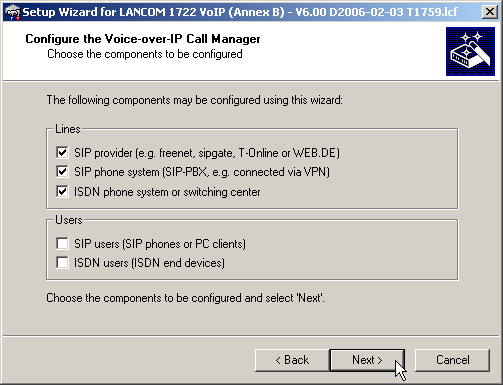
- Configure the device as described in the preceding examples:
- one line to a SIP provider
- ISDN line with MSN mapping
- Area and country code for each location
- Enter a unique domain for the local VoIP domain which describes the local VoIP range for the site. Both sites use different VoIP domains, e.g. 'location_A.internal' or 'location_B.internal'.
- Configure the line leading to the SIP PBX with the following values:
- SIP PBX line name: Unique name for the line leading to the remote site.
- PBX SIP domain/realm: Internal VoIP domain for the remote site.
- Registrar (FQDN or IP): Address for the LANCOM at the remote site, in the event that
the device cannot be identified via DNS resolution of the VoIP domain (PBX SIP
domain/realm).Note: Use the private IP address that can be reached via VPN for the LANCOM here, not the public IP.
- Leave the field for the shared password empty when registering to the SIP PBX.
- Leave the field for the public PBX number empty.
- The call routing table suggested by the setup wizard automatically allows international
and national long distance calls to be made via remote site's line, local calls
are routed via ISDN.
- In addition, a standard route directs all numbers which cannot be resolved to the remote location's line.
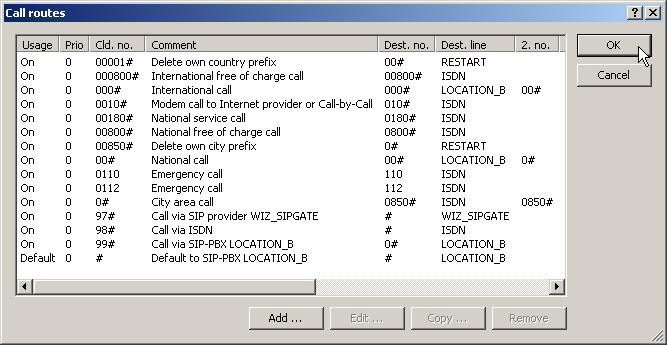
- Adapt the suggested call routing table in order to make international and national long distance calls via the SIP provider line with backup over ISDN. When doing so, please observe that the '0' preceding the number must be removed.
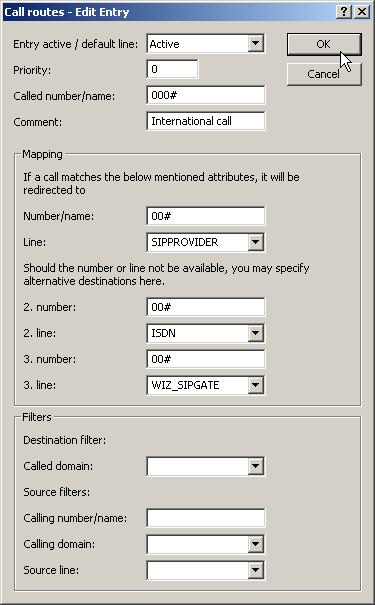
- After being adapted for international and national long
distance, the call routing table should appear as follows:
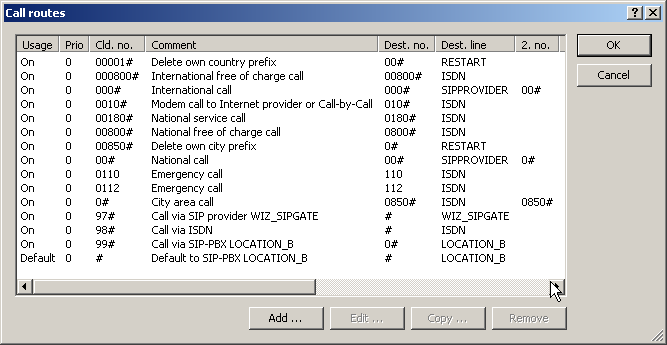
- In this state, all calls that cannot be resolved by the call routing table and which do
not have a corresponding entry in the local user list are automatically forwarded to the
remote site.
- If this is not desired, for example, where more than two sites are connected in this way, an additional entry can detect only the internal calls to a particular site. For this, make a new entry (for the number range '20' to '29' at location B) in the call routing table with the following values:
- Called number / name: e.g. '2#' for all numbers that begin with a 2.
- Number / name: The number called is remains unchanged and is used as a destination number, i.e. here, also '2#'.
- Line: Enter the SIP PBX line for the remote location here, i.e. 'LOCATION_B'.
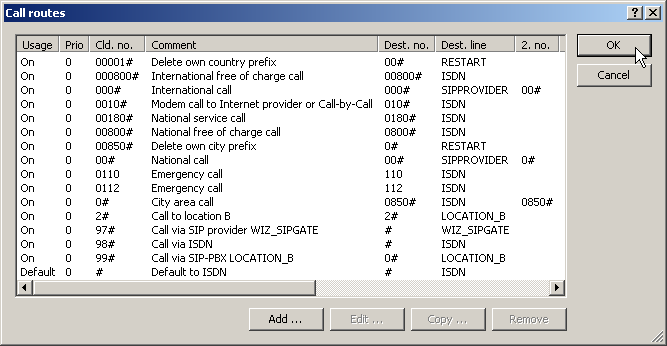
Note: This entry for 'LOCATION_B' is placed well down toward the end of the call routing table so as not to affect the more general rules. However, for interaction with the other routes, verify that only the internal numbers for the remote site are directed to the respective line.